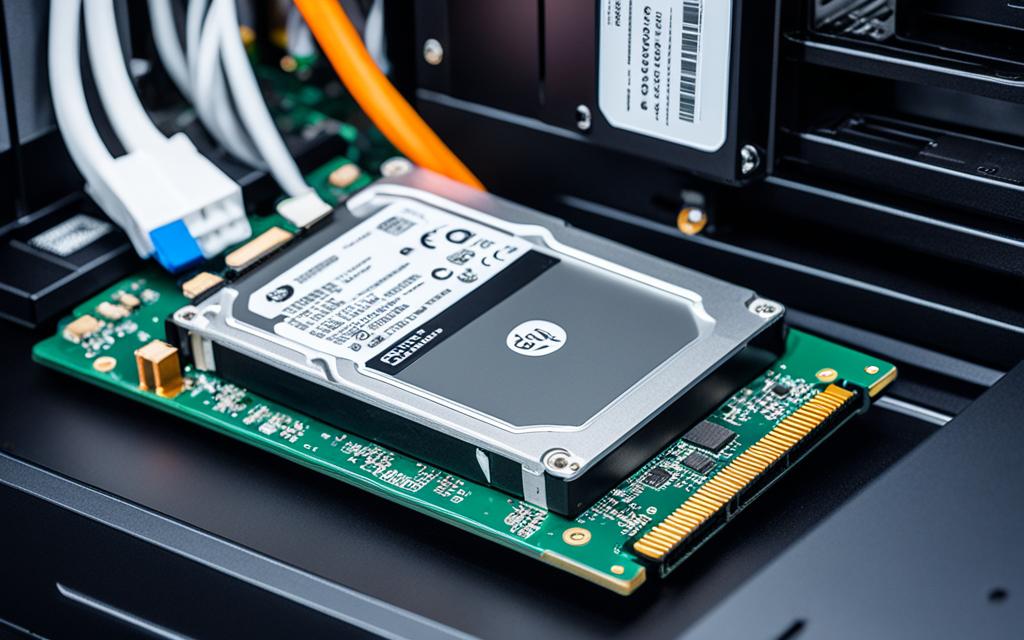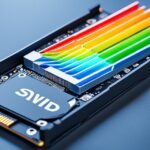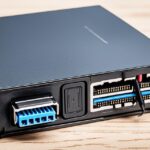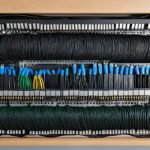Table of Contents
Many wonder if SSDs need their own power supply, no matter their computing skill level. SSDs are key for fast and dependable computers. But, how they get power varies by type. Most internal SSDs use connections on the motherboard and the power supply unit (PSU) for power. This shows why knowing about SSD power requirements matters. On the other hand, external SSDs get power from USB ports, so they don’t need their own power supply. Understanding these differences is crucial for the best system performance and smooth use. When upgrading or making a new computer, knowing this can boost your SSD’s efficiency123.
Key Takeaways
- Internal SSDs require power via specific cables connected to the PSU.
- External SSDs generally receive power through USB connections.
- Understanding SSD power requirements aids in building optimal systems.
- Efficient power delivery helps in extending the lifespan of SSDs.
- Proper installation of SSDs enhances system responsiveness and performance.
Understanding Solid State Drives (SSD)
The world of computing has seen a major change with the introduction of solid-state drives, or SSDs. These drives use advanced technology to store and manage data differently. They are a big step forward from older storage methods.
What is an SSD?
An SSD is a type of storage device that uses NAND flash memory. It doesn’t have the spinning disks found in hard disk drives (HDDs). This means SSDs work much faster, making them great for when you need to access data quickly4. They are known for their speed in reading and writing data, and for starting up programs quickly4. This speed boost is why many people and businesses prefer SSDs for better performance.
Advantages of Using an SSD
SSDs come with many benefits. One major advantage is their durability; they can handle bumps and drops much better because they don’t have moving parts4. This makes them more reliable than HDDs. They also use less power, which means laptops run longer on a single charge and they save on energy costs5.
Other benefits of SSDs include:
- Faster boot times, improving productivity and efficiency.
- Quicker application loading, for a better user experience.
- Silence during operation, thanks to having no moving parts.
- Less heat generation, which is good for the computer’s performance.
The SSD market is growing, offering more choices for different needs. Moving to an SSD not only enhances your computer’s performance but comes with several great benefits. Learn more about installing an SSD
Does an SSD Need Power Supply?
To get the best from SSDs, knowing their power needs is key. These needs vary greatly between internal and external SSDs, because of how they’re designed and work.
Internal SSD Power Requirements
Internal SSDs like the 2.5-inch SATA and M.2 NVMe types need their own power. For example, a 2.5-inch SATA SSD uses about 0.25-2 watts when not in use. But, when reading or writing, it needs 4-8 watts and 5-8 watts respectively6.
On the other hand, M.2 PCI-Express NVMe SSDs need more power. They use about 0.50-3 watts when idle. During reading and writing, they require 2-8 watts and 3-10 watts respectively6. So, it’s crucial to know the power consumption of the SSD you’re installing.
External SSD Power Requirements
External SSDs work a bit differently. They get power straight from USB connections. This makes setting them up and carrying them around easier. Most use USB 3.0 or newer tech. This means they don’t need extra cables for power.
These drives are great for those who need a simple way to store and move data. Their ease of use matches today’s computing needs. Knowing the power supply differences can help when choosing an SSD7.
Cable and Connection Types for SSDs
Understanding the different types of cables and connections is key when adding SSDs to a computer. You’ll mainly come across SATA and M.2 NVMe connections. Each type plays a crucial role in performance and compatibility.
SATA Connections for 2.5” SSDs
SATA connections are essential for hooking up 2.5” SSDs. These drives need a SATA data cable for the motherboard and a power cable from the power supply unit (PSU). Missing one of these can cause issues. A good power cable matters because it provides stable power. This stability boosts the SSD’s life and reliability. SSDs are great for their speed, reliability, and they use less power than hard drives, which saves energy3.Proper power connection is crucial to avoid problems.
M.2 and NVMe SSDs Explained
M.2 and M.2 NVMe SSDs stand out because they connect to the motherboard differently. They plug into the M.2 slot without extra cables. This makes setting them up easier and they work better by using the PCIe bus for both data and power. SSDs inside a computer get power from the motherboard. External ones get power through USB ports, needing less power thanks to their design8. M.2 and SATA SSDs are both excellent for boosting a system’s performance.
The Importance of Proper Power Supply
A good power supply is key to SSD speed and efficiency. It makes sure SSDs work smoothly, boosting their speed and life. A reliable power supply keeps SSDs at top performance, much faster than old HDDs3. It helps SSDs to process data quickly and without problems.
Impact of a Stable Power Supply on SSD Performance
SSDs are better than HDDs in speed, lasting longer, and using less energy. A stable power supply means fewer breaks or issues since SSDs don’t have moving parts3. Good power cables also stop overheating and electrical troubles. SSDs are quiet, make less heat, and use less energy, showing the need for steady power3.
Consequences of Insufficient Power Supply
A poor power supply harms SSDs. It can mess up data and cause crashes, making the SSD less reliable3. You might see sudden drops in how well it works or even harm it. Using strong power cables that give enough power helps avoid these issues. It makes SSDs last longer.
| Power Supply Quality | Consequences | Benefits |
|---|---|---|
| High Quality | Reduced risk of data corruption | Enhanced SSD longevity and performance |
| Low Quality | Increased likelihood of crashes | Lower performance and reliability |
Learn more about SSD technology and its benefits by visiting this page3.
How SSDs Retain Data Without Continuous Power
It’s important to know how SSDs keep your data safe. They use NAND flash memory to store info without needing power. This technology stores data in tiny charges inside cells. It’s what makes SSD data retention work well.
NAND Flash Memory and Data Retention
NAND flash memory comes in several forms like SLC, MLC, TLC, and QLC. Each type fits different needs. SLC is known for being reliable and fast, perfect for business use. MLC strikes a balance between affordability and performance. TLC and QLC are favoured in gadgets for their large storage and low cost. Knowing the differences helps us understand how SSDs keep data without power. Usually, an SSD can keep data safe for about 2 to 5 years under the right conditions. Yet, they might start to have problems after 5 years of regular use9.
How Long Can SSDs Hold Data Without Power?
SSDs can’t hold data without power forever. Things like temperature and how you store them can affect their ability to keep data. For important uses where keeping data safe from power loss is key, always make regular backups. Because SSDs can be harmed by power spikes, it’s smart to have a strong backup plan. This helps stop data from being lost9.
Conclusion
Understanding SSD power requirements is key to better computing. The SSD power supply summary shows that internal SSDs need specific power connections. Yet, external SSDs use advanced USB tech, making setup easier. Proper connections and quality cables are vital for good performance and long life.
Statistics show people are looking into ways to efficiently manage their SSDs. All participants noted concerns about viruses and power stability10. About 80% considered manual power switches for better control10. This shows a careful approach to safeguarding data and enhancing performance.
With SSD technology continually improving, knowing about these needs is crucial. By opting for the right power solutions and grasping the mechanics, you can improve both efficiency and reliability of digital storage.
FAQ
Does an SSD need a power supply?
Yes, internal SSDs need to be connected to the power supply and motherboard through certain cables. Meanwhile, external SSDs get power straight from USB connections.
What are the advantages of using an SSD?
SSDs have many benefits. They make computers start faster and apps load quicker. They also run quietly, produce less heat, and are more reliable than HDDs.
Q/ What are the power requirements for internal and external SSDs?
Internal SSDs, like 2.5” SATA and M.2 NVMe ones, need a direct power cable from the PSU. External SSDs use power from USB connections. This means they don’t need a separate power source.
What types of cables are used for connecting SSDs?
Standard SATA data and power cables are needed for 2.5” SATA SSDs. M.2 NVMe SSDs plug directly into the motherboard’s M.2 slot, so no extra cables are needed.
How does a stable power supply affect SSD performance?
A steady power supply keeps an SSD running smoothly, ensuring top speed and reliability. If the power is weak, it might cause data loss and drive failure.
How can insufficient power supply impact SSDs?
Not having enough power can lead to lost data, regular system crashes, and even total damage to the SSD. It shows how crucial a reliable power source is.
How do SSDs retain data without continuous power?
SSDs use NAND flash memory to save data, meaning they can keep information even when not powered. Usually, data stays safe for 2 to 5 years if conditions are right.
What factors can affect the data retention of an SSD?
The life span of SSD data can be shortened by factors like temperature and humidity. Therefore, it’s vital to store them correctly for lasting use.
Source Links
- https://www.intel.com/content/www/us/en/gaming/resources/power-supply.html – How to Choose Power Supply for PC: What to Know – Intel
- https://www.kingston.com/en/blog/pc-performance/install-2-5-inch-ssd – How to Install an Internal 2.5” SSD- Kingston Technology
- https://www.electronicshub.org/what-cables-do-i-need-for-ssd/ – What Cables Do I Need For SSD?
- https://www.techtarget.com/searchstorage/definition/SSD-solid-state-drive – What is an SSD (Solid-State Drive)?
- https://kinsta.com/blog/what-is-ssd/ – What Is SSD? Everything You Need to Know About Solid-State Storage
- https://www.superssd.com/kb/ssd-power-consumption/ – SSD Power Consumption: What to Expect | SuperSSD
- https://www.ibm.com/think/topics/hard-disk-drive-vs-solid-state-drive – Hard Disk Drive (HDD) vs. Solid State Drive (SSD) | IBM
- https://www.easeus.com/resource/does-ssd-need-power.html – Does SSD Need the Power to Retain Data? The Answers Are Here!
- https://datarecovery.com/rd/how-do-solid-state-drives-store-data/ – How Do Solid State Drives Store Data? – Datarecovery.com
- https://community.wd.com/t/can-power-to-ssd-be-switched-off/265156 – Can power to SSD be switched off?








